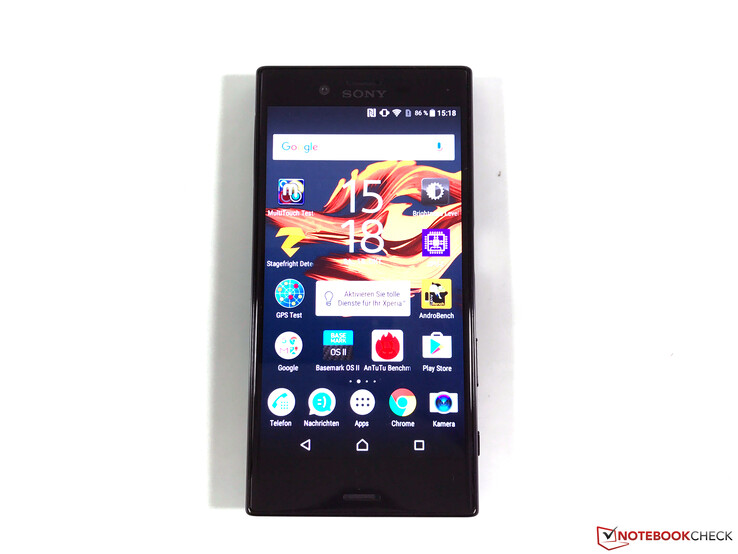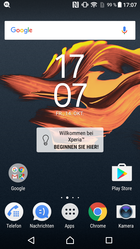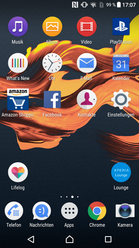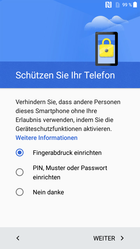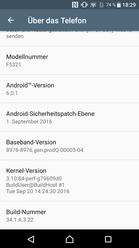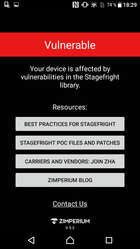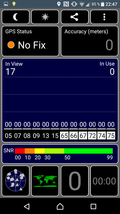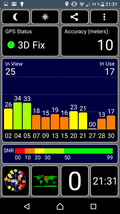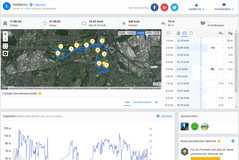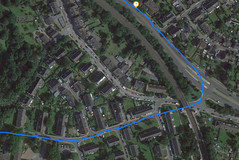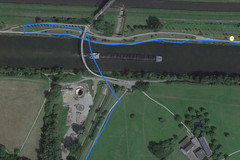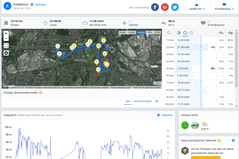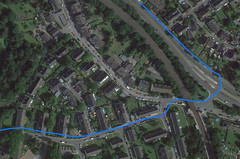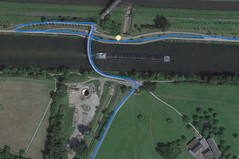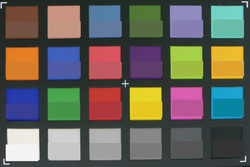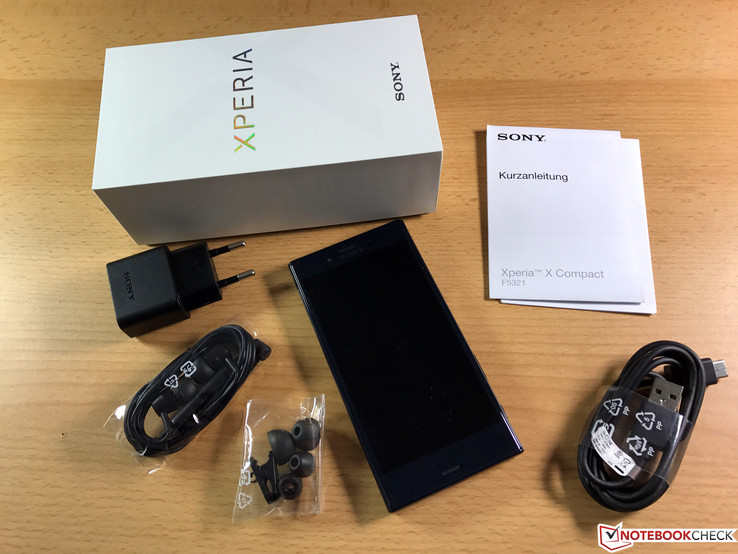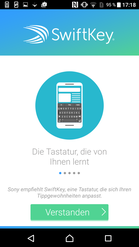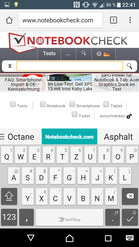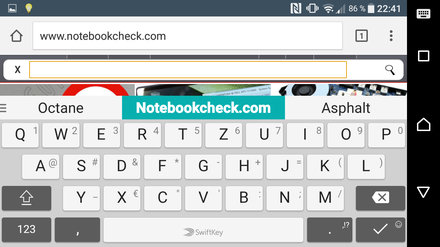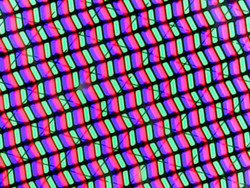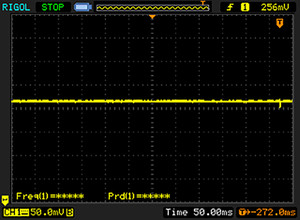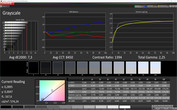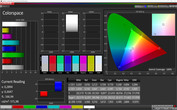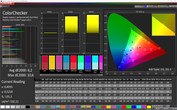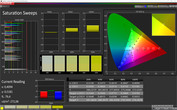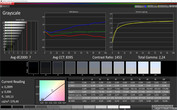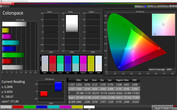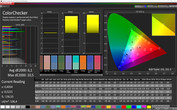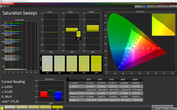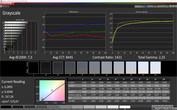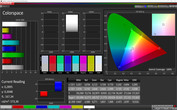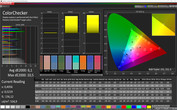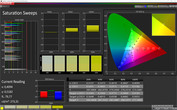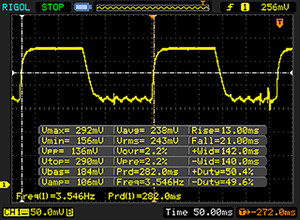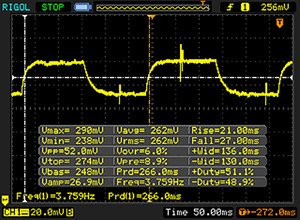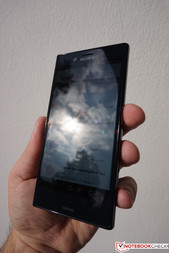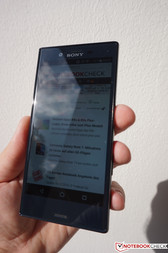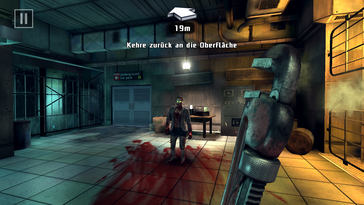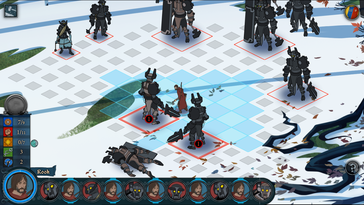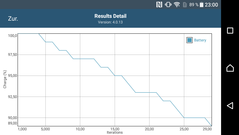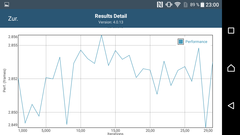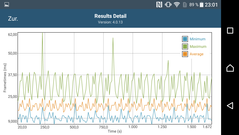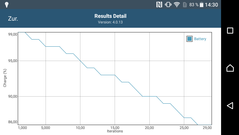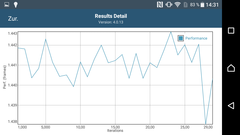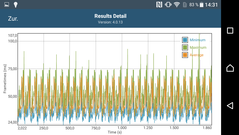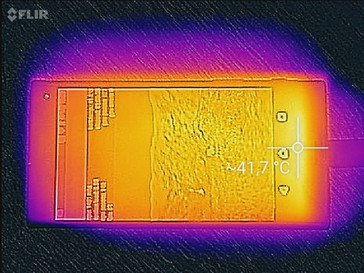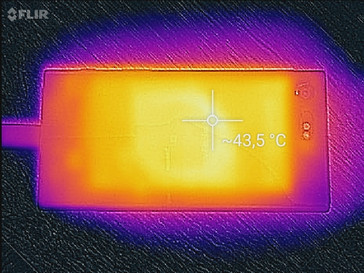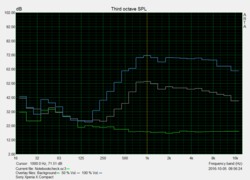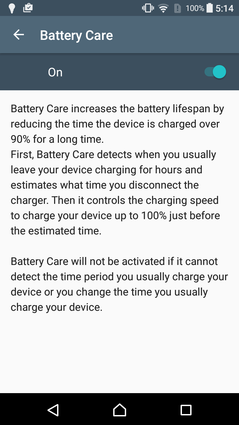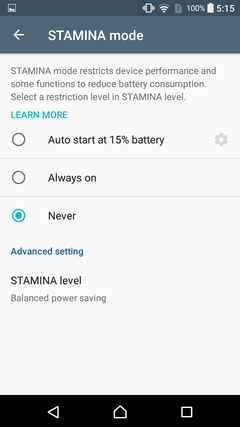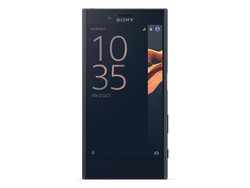Sony Xperia X Compact Smartphone Review

For the original German review, see here.
Sony was one of the last manufacturers of Android smartphones that is still offering compact devices with very powerful components. The previous Xperia Z5 Compact managed a very good result in our review and is still sitting in our Top 10 Ranking. However, this has changed since Sony offers high-end hardware only in smartphones with display sizes of 5 inches and more from now on.
Our review unit today is the Sony Xperia X Compact. It is the direct successor to the Xperia Z5 Compact and the design is similar to its larger sibling Xperia XZ, but the performance has been reduced. The new Compact model is no longer powered by high-end SoCs from the Snapdragon 8xx-series, but the mainstream chip Qualcomm Snapdragon 650. The IP certification against dust and water has also been waived for the new model. Still, looking at the specification details, the 4.6-inch smartphone does not reveal any serious drawbacks: a 23 MP camera, 3 GB of RAM, 32 GB of internal storage plus a microSD-slot, fast wireless connections and a fingerprint scanner.
Priced at 449 Euros (~$489; RRP), Sony has also reduced the price (100 Euros/~$109 less than the Z5 Compact). The search for suitable comparison devices is not easy. Apart from Sony, Apple is pretty much the only remaining manufacturer of small and powerful devices. In addition to the fast iPhone SE with a 4-inch display, the 4.7-inch iPhone 6s is also an interesting though more expensive alternative. The Android competition starts at 5 inches. Sony also offers the regular Xperia X with a 5-inch screen and similar performance figures. The predecessor Z5 Compact is still available as well. Also priced at around 400 Euros (~$436) are the brand-new Honor 8 and the familiar OnePlus 3.
Case
Despite the similar model series, the design of the two new models Xperia X Compact and Xperia XZ differs from the regular Xperia X. While the shape of the new models is once again a bit boxier, the sides are now more rounded. This helps the X Compact in particular, which does not really meet the compact expectations with a thickness of 9.5 millimeters (~0.37 in). This means that it is much thicker than all the comparison devices – the previous Z5 Compact was 0.6 millimeters (~0.02 in) thinner as well. At least, there is no camera bump at the back and the situation is better when we look at the other dimensions of the Xperia X Compact. The handling also benefits from the rounded sides and is okay in general, but you will still clearly notice the Sony in your pocket.
Unlike the other current X models, the X Compact does not get a metal chassis and is exclusively made of glossy plastics. Our test model is the "Universe Black" model, but Sony also offers a white and a "Mist Blue" version. Because of the plastic, the smartphone does unfortunately feel very slippery and will quickly collect fingerprints as well as dust. Our test model also had problems with a lot of small scratches – even though we handled it with a lot of care. The silver-colored power button with the integrated fingerprint scanner does not really fit into the otherwise completely black appearance either. Sony has also waived the IP certification for the protection against dust and water.
Pressure is not a problem for the test model. We could not provoke picture distortions, but noticed quiet creaking sounds. Overall, however, the build quality is very good and the material transitions are very clean. The buttons for the camera and the volume rocker on the other hand wiggle a bit and also create a pretty loud clicking sound.
The video below shows a short hands-on with the Xperia X Compact and the larger Xperia XZ from the last IFA in Berlin. Among others, you can see the available colors for the test model.
Connectivity
We have already mentioned that Sony no longer implements a high-end SoC and uses the mainstream chip Snapdragon 650 with the integrated Adreno 510 GPU instead. However, Sony does not save on the memory equipment and ships the smartphone with 3 GB of RAM as well as 32 GB of internal storage. Android 6.0 Marshmallow does require an unusual amount of space and therefore, the user can only use about 20 GB for files and apps – competitors usually offer 24 to 26 GB. At least, it is possible to expand the storage via a microSD-card by up to 256 GB. Apps can be transferred to the card and pictures as well as videos can be stored there, but the microSD-card cannot be formatted as internal storage.
Unlike the larger Xperia X, the X Compact supports USB-OTG, but still no MHL. Sony has also implemented a USB Type-C port, but it is still a 2.0 jack – although this is also the case for the rivals. Other connectivity features include Bluetooth 4.2, NFC, Wi-Fi Direct, FM radio, DLNA, and Miracast. There is also a multi-colored notification LED on the front, which indicates incoming messages or the battery charge, but you cannot configure it.
Software
The Xperia X Compact is shipped with Android 6.0 Marshmallow. Sony also uses its own user interface, including some additional apps (such as Spotify or PlayStation, for example). These can only be deactivated by the user, but not deleted. There was a software update after we set the smartphone up and it did update the Android Security Patch Level to September 1st, 2016. Overall, Sony has not changed a lot of things and the whole handling is very smooth, but you will sometimes have to search quite a bit before you find the desired setting (like the storage management). Handy: You can also activate the smartphone with a double tap on the screen.
According to Sony, the Xperia X Compact is one of the models that will receive an update to Android 7. There is currently no information about the exact time frame though.
Communication and GPS
The communication modules cover modern standards with LTE Cat. 6 and WLAN 802.11ac. There are devices with even faster solutions (e.g. LTE Cat. 9), but up to 300 Mbps downstream and 50 Mbps upstream, respectively, is still pretty fast. We did not have any signal problems in the metropolitan T-Mobile network and the overall signal quality was comparable to a simultaneously used Apple iPhone 7. We did not encounter any issues in our wireless network and web browsing was very quick. Our standardized WLAN test (router Linksys EA8500, ~1 meter/~3 ft away) determined average transfer rates for the Xperia X Compact. The receiving performance was just ahead of the OnePlus 3 at 327 Mbps, but the latter has the edge when the device sends data (323 vs. 214 Mbps for the Sony).
| Networking | |
| iperf3 transmit AX12 | |
| OnePlus 3 | |
| Sony Xperia X Compact | |
| iperf3 receive AX12 | |
| Sony Xperia X Compact | |
| OnePlus 3 | |
The location can be determined via GPS and GLONASS, even though we could not get a signal inside the building. The connection with the satellites was established within a few seconds outdoors, but the accuracy was not perfect at 10 meters (~33 ft). We also check the performance on a bicycle ride and compare the results with the professional navigation device Garmin Edge 500. We cannot see any serious problems here, but the smartphone does not locate the position quite as often, so there can be some "shortcuts". The overall track length was about 300 meters (~328 yd) shorter. There should not be any problems when you use it for car navigation.
Telephone and Voice Quality
The Sony Xperia X Compact has only one Nano-SIM slot and unfortunately, replacing the card will require a restart. This might not be an issue for many users, but it will be annoying if you travel a lot and therefore use more than one SIM-card. As with the previous Z5 Compact, the test model convinced with good voice quality without any background noises. This also applies to the hands-free feature and the provided headset, although the microphone has some problems with wind noises. The Phone app is basically the default Android app and the handling should not be a problem for any user.
Cameras
The front camera of the Xperia X Compact has not changed compared to the predecessor Z5 Compact. You still get a 5 MP sensor (25 mm wide angle lens), which does at least produce acceptable pictures in good lighting condition. However, the results are never really sharp (see sample shot). Low-light situations will quickly result in picture noise and there is no flash. Videos can be recorded in Full HD.
The camera equipment at the back is similar to the larger Xperia X. The 23 MP Exmor-R sensor has a predictive autofocus, which can follow objects autonomously. You just have to tap on the screen to focus, and as with the larger sibling, it worked well in practice. However, the camera app is rather annoying. Although it does feature a comprehensive manual mode, it launches in the automatic mode by default. The maximum resolution has to be set manually as well and the different picture modes are only available for 8 MP images. Unlike the predecessor, you cannot shoot 4K videos anymore – the maximum resolution is 1080p at 60 frames per second. The dedicated camera button (launch the app and trigger) at the right side of the case is quite handy.
In terms of quality, the camera leaves a good impression. You will only start to see some blurs when you zoom in, which is particularly noticeable in the vegetation. The direct rival OnePlus 3 performs better in this respect. We are not fully convinced by the low-light result (scene 3) either. There is only minor picture noise and the displayed contents are good to see, but you cannot see as many details as on the OnePlus 3, for example. A good example is the fence on the right side or the tree left next to the lantern.
In addition to our usual sample pictures, we also evaluate the color accuracy and the sharpness under controlled lighting conditions. The pictures are not edited afterwards and there is no manual white balance either. The Sony sensor shows the colors very accurately and there are no drastic deviations, only some shades are – similar to the larger Xperia X – slightly too bright. Our test chart is very sharp, and the device benefits from the high resolution here. Even the crop from the center shows only minor blurs at the edges. Overall, a good performance.
Accessories and Warranty
Sony ships the Xperia X Compact with the usual accessories including a modular power adapter, USB cable, headset with different tips, a quick-start guide and the warranty card. There are also some optional accessories such as covers, high-res headphones or docking stations. The warranty period is 24 months. Please see our Guarantees, Return Policies & Warranties FAQ for country-specific information.
Input Devices and Handling
Sony uses the very comprehensive SwiftKey keyboard by default (the standard Google keyboard is also available). It can be a bit crowded at first and needs some getting used to, but it works very well. Overall, we quite liked the handling of the Xperia X Compact. Both the user interface as well as web browsing experience were very smooth.
The fingerprint scanner inside the power button is both quick and reliable. The whole button is slightly depressed and can be found very easily with the finger. As mentioned before, the other two physical buttons are a little wobbly and also produce a pretty loud clicking sound.
Although there is actually sufficient space underneath the panel, Sony only implements on-screen Android buttons. This means that the space on the small display is further reduced. The touchscreen itself, however, does not cause any criticism and works well even in the peripheral areas. It can recognize up to ten inputs simultaneously, even though this is not so important on the small screen.
Display
Sony is still using a 4.6-inch Triluminos display (IPS) with a resolution of 1280x720 pixels. This results in a pixel density of 320 PPI, which is sufficient for sharp texts and images, but you can notice a difference compared to higher resolution screens in a direct comparison. The Full HD resolution is once again reserved for the new flagship Xperia XZ as well as the regular Xperia X this year.
Our initial measurements are quite positive. The maximum luminance is very good at 580 nits on average and the black value has improved compared to the previous model and is now at 0.4 cd/m². The resulting contrast ratio of more than 1400:1 is excellent (results for a pure white picture and APL50 are almost identical) and marks the best value within our comparison group except for the OLED panel of the OnePlus 3. We could not detect PWM flickering. Our subjective impression is quite good, but there is unfortunately a blue cast, which is particularly visible on bright surfaces.
Screen Flickering / PWM (Pulse-Width Modulation)
| Screen flickering / PWM not detected | |||
In comparison: 53 % of all tested devices do not use PWM to dim the display. If PWM was detected, an average of 17900 (minimum: 5 - maximum: 3846000) Hz was measured. | |||
| |||||||||||||||||||||||||
Brightness Distribution: 88 %
Center on Battery: 579 cd/m²
Contrast: 1448:1 (Black: 0.4 cd/m²)
ΔE Color 6.1 | 0.5-29.43 Ø5
ΔE Greyscale 7 | 0.57-98 Ø5.3
Gamma: 2.24
| Sony Xperia X Compact IPS, 1280x720, 4.60 | Honor 8 IPS, 1920x1080, 5.20 | Sony Xperia Z5 Compact IPS, 1280x720, 4.60 | Apple iPhone SE IPS, 1136x640, 4.00 | Apple iPhone 6S IPS, 1334x750, 4.70 | Sony Xperia X LCD, 1920x1080, 5.00 | OnePlus 3 Optic-AMOLED, 1920x1080, 5.50 | |
|---|---|---|---|---|---|---|---|
| Screen | -5% | -16% | 6% | 11% | -33% | 3% | |
| Brightness middle | 579 | 451 -22% | 547 -6% | 603 4% | 552 -5% | 404 -30% | 419 -28% |
| Brightness | 563 | 443 -21% | 532 -6% | 579 3% | 549 -2% | 392 -30% | 431 -23% |
| Brightness Distribution | 88 | 93 6% | 94 7% | 93 6% | 87 -1% | 91 3% | 84 -5% |
| Black Level * | 0.4 | 0.4 -0% | 0.54 -35% | 0.88 -120% | 0.39 2% | 0.68 -70% | |
| Contrast | 1448 | 1128 -22% | 1013 -30% | 685 -53% | 1415 -2% | 594 -59% | |
| Colorchecker dE 2000 * | 6.1 | 5.4 11% | 7.37 -21% | 1.8 70% | 3.4 44% | 7.1 -16% | 4.1 33% |
| Colorchecker dE 2000 max. * | 10.5 | 9.9 6% | 3.5 67% | 13.2 -26% | 12 -14% | ||
| Greyscale dE 2000 * | 7 | 6.7 4% | 8.39 -20% | 2.3 67% | 4.16 41% | 9.7 -39% | 3.3 53% |
| Gamma | 2.24 98% | 2.33 94% | 2.28 96% | 2.21 100% | 2.21 100% | 2.23 99% | 2.1 105% |
| CCT | 8395 77% | 8262 79% | 9074 72% | 6955 93% | 7288 89% | 9502 68% | 6550 99% |
| Color Space (Percent of sRGB) | 99.9865 | 96.74 | 95.93 | 100 | |||
| Color Space (Percent of AdobeRGB 1998) | 62.13 | 62.18 | 89.38 |
* ... smaller is better
This blue cast is also confirmed by the other display measurements. The DeltaE-2000 deviations for the colors and the grayscale are also pretty high ex-works, and the three different picture modes (Off, X-Reality, Super-vivid) hardly differ at all here. We can measure the best results in the X-Reality mode with 7 (grayscale) and 6.1 (colors), respectively. Only the predecessor Z5 Compact and the Xperia X are slightly worse, but all the other rivals manage more accurate colors. At least the blue cast can be improved a bit thanks to the manual white balance.
Display Response Times
| ↔ Response Time Black to White | ||
|---|---|---|
| 34 ms ... rise ↗ and fall ↘ combined | ↗ 13 ms rise | |
| ↘ 21 ms fall | ||
| The screen shows slow response rates in our tests and will be unsatisfactory for gamers. In comparison, all tested devices range from 0.1 (minimum) to 240 (maximum) ms. » 89 % of all devices are better. This means that the measured response time is worse than the average of all tested devices (21.5 ms). | ||
| ↔ Response Time 50% Grey to 80% Grey | ||
| 48 ms ... rise ↗ and fall ↘ combined | ↗ 21 ms rise | |
| ↘ 27 ms fall | ||
| The screen shows slow response rates in our tests and will be unsatisfactory for gamers. In comparison, all tested devices range from 0.2 (minimum) to 636 (maximum) ms. » 80 % of all devices are better. This means that the measured response time is worse than the average of all tested devices (33.7 ms). | ||
The maximum luminance is available with the manual as well as the automatic brightness control. In combination with the high contrast ratio, you can even see the display content in very bright environments. As with almost every other smartphone, you should avoid reflections from direct light sources on the glossy screen. The panel is based on the IPS technology and offers wide viewing angles. Colors do not distort even from very flat angles, only the luminance drops slightly in this case.
Performance
We have already mentioned that Sony does not use a high-end SoC from the Snapdragon 8xx-series for its Compact model this year and implements a Snapdragon 650 instead. This mainstream chip has 6 CPU cores (2x Cortex-A72 at up to 1.8 GHz and 4x Cortex-A53 at up to 1.2 GHz) and the graphics card Adreno 510, which is a lower clocked version of the Adreno 530. The single-core performance is roughly on par with the old Snapdragon 810, but the old Xperia Z5 Compact is faster when you stress multiple cores or the GPU.
It is not surprising that our test model produces similar performance figures compared to the larger Xperia X, which is equipped with the same SoC. If you take all the benchmark results, the two Sony smartphones are at the bottom of the ranking within our comparison group. Subjectively however, the Xperia X Compact is sufficiently quick and the whole handling is very smooth, only the loading times of apps can be a bit longer.
| AnTuTu v6 - Total Score | |
| OnePlus 3 | |
| Apple iPhone SE | |
| Honor 8 | |
| Sony Xperia X | |
| Sony Xperia X Compact | |
| Geekbench 3 | |
| 64 Bit Single-Core Score | |
| Apple iPhone 6S | |
| Apple iPhone SE | |
| OnePlus 3 | |
| Sony Xperia X Compact | |
| Sony Xperia X | |
| 64 Bit Multi-Core Score | |
| OnePlus 3 | |
| Apple iPhone 6S | |
| Apple iPhone SE | |
| Sony Xperia X Compact | |
| Sony Xperia X | |
| Geekbench 4.0 | |
| 64 Bit Single-Core Score | |
| OnePlus 3 | |
| Honor 8 | |
| Sony Xperia X Compact | |
| 64 Bit Multi-Core Score | |
| Honor 8 | |
| OnePlus 3 | |
| Sony Xperia X Compact | |
| GFXBench (DX / GLBenchmark) 2.7 | |
| T-Rex Onscreen | |
| OnePlus 3 | |
| Apple iPhone SE | |
| Apple iPhone 6S | |
| Sony Xperia Z5 Compact | |
| Sony Xperia X Compact | |
| Honor 8 | |
| Sony Xperia X | |
| 1920x1080 T-Rex Offscreen | |
| OnePlus 3 | |
| Apple iPhone SE | |
| Apple iPhone 6S | |
| Sony Xperia Z5 Compact | |
| Honor 8 | |
| Sony Xperia X Compact | |
| Sony Xperia X | |
| GFXBench 3.0 | |
| on screen Manhattan Onscreen OGL | |
| Apple iPhone SE | |
| Apple iPhone 6S | |
| OnePlus 3 | |
| Sony Xperia Z5 Compact | |
| Sony Xperia X Compact | |
| Honor 8 | |
| Sony Xperia X | |
| 1920x1080 1080p Manhattan Offscreen | |
| OnePlus 3 | |
| Apple iPhone SE | |
| Apple iPhone 6S | |
| Sony Xperia Z5 Compact | |
| Honor 8 | |
| Sony Xperia X Compact | |
| Sony Xperia X | |
| GFXBench 3.1 | |
| on screen Manhattan ES 3.1 Onscreen | |
| Apple iPhone SE | |
| Sony Xperia Z5 Compact | |
| OnePlus 3 | |
| Sony Xperia X Compact | |
| Honor 8 | |
| Sony Xperia X | |
| 1920x1080 Manhattan ES 3.1 Offscreen | |
| OnePlus 3 | |
| Apple iPhone SE | |
| Sony Xperia Z5 Compact | |
| Honor 8 | |
| Sony Xperia X Compact | |
| Sony Xperia X | |
| GFXBench | |
| on screen Car Chase Onscreen | |
| OnePlus 3 | |
| Sony Xperia X Compact | |
| Honor 8 | |
| Sony Xperia X | |
| 1920x1080 Car Chase Offscreen | |
| OnePlus 3 | |
| Honor 8 | |
| Sony Xperia X Compact | |
| Sony Xperia X | |
| PCMark for Android - Work performance score | |
| OnePlus 3 | |
| Honor 8 | |
| Sony Xperia X Compact | |
| Sony Xperia X | |
| Sony Xperia Z5 Compact | |
We performed the browser tests with the preloaded Chrome 53, because Sony does not install its own version. The devices from Sony are once again at the bottom of the charts, but the old Z5 Compact is beaten (which is also a result of the older browser version). In practice however, there is no criticism.
| Octane V2 - Total Score | |
| Apple iPhone SE | |
| Apple iPhone 6S | |
| Honor 8 | |
| OnePlus 3 | |
| Sony Xperia X Compact | |
| Sony Xperia X | |
| Sony Xperia Z5 Compact | |
| Mozilla Kraken 1.1 - Total | |
| Sony Xperia Z5 Compact | |
| Sony Xperia X | |
| Sony Xperia X Compact | |
| Honor 8 | |
| OnePlus 3 | |
| Apple iPhone 6S | |
| Apple iPhone SE | |
| WebXPRT 2015 - Overall | |
| Apple iPhone 6S | |
| Apple iPhone SE | |
| Honor 8 | |
| OnePlus 3 | |
| Sony Xperia X Compact | |
| Sony Xperia Z5 Compact | |
| Sony Xperia X | |
| JetStream 1.1 - Total Score | |
| Apple iPhone SE | |
| Apple iPhone 6S | |
| Honor 8 | |
| OnePlus 3 | |
| Sony Xperia X Compact | |
| Sony Xperia X | |
| Sony Xperia Z5 Compact | |
* ... smaller is better
Compared to the predecessor Z5 Compact, the internal storage of the Sony Xperia X Compact with a capacity of 32 GB is slightly faster, but still only average. The two rivals Honor 8 and OnePlus 3 in particular have an advantage here. The card reader is not the fastest either. We can only determine 33/28 MB/s (read/write) with our reference card Toshiba Exceria Pro (up to 95/80 MB/s).
| Sony Xperia X Compact Adreno 510, 650 MSM8956, 32 GB eMMC Flash | Honor 8 Mali-T880 MP4, Kirin 950, 32 GB eMMC Flash | Sony Xperia Z5 Compact Adreno 430, 810 MSM8994, 32 GB eMMC Flash | Sony Xperia X Adreno 510, 650 MSM8956, 32 GB eMMC Flash | OnePlus 3 Adreno 530, 820 MSM8996, 64 GB UFS 2.0 Flash | |
|---|---|---|---|---|---|
| AndroBench 3-5 | 51% | -22% | -17% | 135% | |
| Sequential Write 256KB SDCard | 27.57 | 23.59 -14% | 12.82 -54% | ||
| Sequential Read 256KB SDCard | 32.54 | 53.7 65% | 17.67 -46% | ||
| Random Write 4KB | 9.3 | 31.5 239% | 7.81 -16% | 10.26 10% | 18.23 96% |
| Random Read 4KB | 31.52 | 34.16 8% | 14.15 -55% | 36.28 15% | 137.6 337% |
| Sequential Write 256KB | 139.5 | 119.3 -14% | 88.9 -36% | 117.4 -16% | 153.3 10% |
| Sequential Read 256KB | 207.9 | 247.5 19% | 248.1 19% | 184.3 -11% | 408.7 97% |
Games
Even though the Adreno 510 GPU in the test model is slower than the old Adreno 430 GPU in the predecessor, the performance is still sufficient for modern games. The comparatively low resolution is obviously an advantage here, and even demanding games run smoothly at high details. Two examples are the racing game “Asphalt 8: Airborne”, which runs into the 30-FPS limitation, as well as “Dead Trigger 2”, where the one-minute benchmark sequence is extremely smooth at 60 FPS. Thanks to the well working sensors and the two speakers at the front, we enjoyed gaming, even though you might have to get used to the small screen. It can also affect the handling slightly, which is the case for the strategy game “Banner Saga II”, for example. The control elements are very small on the Xperia X Compact, so you will sometimes hit the wrong
| Asphalt 8: Airborne | |||
| Settings | Value | ||
| high | 30 fps | ||
| Dead Trigger 2 | |||
| Settings | Value | ||
| high | 60 fps | ||
Emissions
Temperature
The lower part of the smartphone does get quite warm with light workloads and the average temperatures are pretty high at 35 °C (~95 °F; front) and 33 °C (~91 °F; back), respectively. The average is around 40 °C (~104 °F) under load, which is perceptible, but not inconvenient in practice.
One advantage of the Mainstream SoC is the performance under sustained load. We use the GFXBench Battery Tests to simulate this scenario. While the performance of the predecessor dropped after a while, it is quite steady in the case of the Xperia X Compact. This is also an advantage over the slimmer sibling Xperia X, where the SoC had to reduce the performance after some runs due to the temperatures.
(±) The maximum temperature on the upper side is 41.2 °C / 106 F, compared to the average of 35 °C / 95 F, ranging from 21.9 to 56 °C for the class Smartphone.
(±) The bottom heats up to a maximum of 41.8 °C / 107 F, compared to the average of 33.8 °C / 93 F
(±) In idle usage, the average temperature for the upper side is 35.4 °C / 96 F, compared to the device average of 32.7 °C / 91 F.
Speakers
No changes in terms of the speakers: Sony still equips the Xperia X Compact with two stereo speakers located at the front of the smartphone. The two modules are not the loudest modules at almost 81 dB(A) and bass is – as expected – not really available, but the sound is still quite balanced in general. It is certainly sufficient for some background music and YouTube videos.
The stereo jack is more interesting for music enthusiasts since the Xperia X Compact also supports high-res audio files. Sony has also implemented some enhancements for bad source files and normal headsets, which will make the sound slightly richer. The sound does get really good with corresponding files. We listened to some lossless audio files and we really liked the low-noise sound quality.
Sony Xperia X Compact audio analysis
(±) | speaker loudness is average but good (80.9 dB)
Bass 100 - 315 Hz
(-) | nearly no bass - on average 31.5% lower than median
(±) | linearity of bass is average (8.8% delta to prev. frequency)
Mids 400 - 2000 Hz
(±) | higher mids - on average 5.6% higher than median
(±) | linearity of mids is average (8.9% delta to prev. frequency)
Highs 2 - 16 kHz
(+) | balanced highs - only 4.4% away from median
(+) | highs are linear (2.2% delta to prev. frequency)
Overall 100 - 16.000 Hz
(±) | linearity of overall sound is average (26% difference to median)
Compared to same class
» 60% of all tested devices in this class were better, 7% similar, 33% worse
» The best had a delta of 12%, average was 38%, worst was 134%
Compared to all devices tested
» 77% of all tested devices were better, 5% similar, 19% worse
» The best had a delta of 4%, average was 25%, worst was 134%
Honor 8 audio analysis
(+) | speakers can play relatively loud (84.7 dB)
Bass 100 - 315 Hz
(-) | nearly no bass - on average 24% lower than median
(±) | linearity of bass is average (12.1% delta to prev. frequency)
Mids 400 - 2000 Hz
(+) | balanced mids - only 4.1% away from median
(+) | mids are linear (5.3% delta to prev. frequency)
Highs 2 - 16 kHz
(±) | higher highs - on average 11.8% higher than median
(±) | linearity of highs is average (7.2% delta to prev. frequency)
Overall 100 - 16.000 Hz
(±) | linearity of overall sound is average (28% difference to median)
Compared to same class
» 68% of all tested devices in this class were better, 5% similar, 26% worse
» The best had a delta of 12%, average was 38%, worst was 134%
Compared to all devices tested
» 82% of all tested devices were better, 3% similar, 14% worse
» The best had a delta of 4%, average was 25%, worst was 134%
Apple iPhone SE audio analysis
(+) | speakers can play relatively loud (83.2 dB)
Bass 100 - 315 Hz
(-) | nearly no bass - on average 25.8% lower than median
(±) | linearity of bass is average (10.2% delta to prev. frequency)
Mids 400 - 2000 Hz
(+) | balanced mids - only 4.8% away from median
(+) | mids are linear (5% delta to prev. frequency)
Highs 2 - 16 kHz
(+) | balanced highs - only 4.5% away from median
(+) | highs are linear (6.2% delta to prev. frequency)
Overall 100 - 16.000 Hz
(±) | linearity of overall sound is average (22.6% difference to median)
Compared to same class
» 42% of all tested devices in this class were better, 7% similar, 51% worse
» The best had a delta of 12%, average was 38%, worst was 134%
Compared to all devices tested
» 62% of all tested devices were better, 6% similar, 32% worse
» The best had a delta of 4%, average was 25%, worst was 134%
Frequency Comparison (Checkboxes select/deselectable!)
Energy Management
Power Consumption
Sony has improved the power consumption of the Xperia X Compact compared to the previous model. The test model is the most power efficient Android devices within this comparison. Only the load consumption is quite high at 8.66 watts – particularly since the power adaptor only provides 7.5 watts. However, the high luminance and the steady performance take their toll. Overall, only the two smartphones from Apple are more power efficient in general. They require much less power under load, despite the higher performance figures.
| Off / Standby | |
| Idle | |
| Load |
|
| Sony Xperia X Compact Wh, 4.60, 1280x720 | Honor 8 11.4 Wh, 5.20, 1920x1080 | Sony Xperia Z5 Compact Wh, 4.60, 1280x720 | Apple iPhone SE 6.21 Wh, 4.00, 1136x640 | Apple iPhone 6S 7 Wh, 4.70, 1334x750 | Sony Xperia X Wh, 5.00, 1920x1080 | OnePlus 3 Wh, 5.50, 1920x1080 | |
|---|---|---|---|---|---|---|---|
| Power Consumption | -32% | -18% | 7% | 3% | -20% | -17% | |
| Idle Minimum * | 0.33 | 0.78 -136% | 0.6 -82% | 0.54 -64% | 0.5 -52% | 0.56 -70% | 0.57 -73% |
| Idle Average * | 1.48 | 1.89 -28% | 1.4 5% | 1.26 15% | 1.6 -8% | 1.69 -14% | 1.24 16% |
| Idle Maximum * | 1.6 | 2.02 -26% | 1.7 -6% | 1.4 12% | 1.9 -19% | 1.75 -9% | 1.36 15% |
| Load Average * | 4.83 | 5.28 -9% | 5.3 -10% | 2.45 49% | 2.5 48% | 6.01 -24% | 5.92 -23% |
| Load Maximum * | 8.66 | 5.44 37% | 8.4 3% | 6.46 25% | 4.8 45% | 7.03 19% | 10.53 -22% |
* ... smaller is better
Battery Runtime
Sony has not changed the integrated 2700-mAh battery and our runtime tests reflect the consumption measurements pretty well. We can only determine little more than three hours under load, only the more powerful Apple iPhone 6s has to be recharged even sooner.
The situation changes in favor of the Xperia X Compact in our practical tests. At an adjusted brightness, we can determine little more than 10 hours both in the WLAN as well as the video test – very good results. Some of the comparison devices even have a little more stamina (iPhones + OnePlus 3), but the runtime should easily last a full business day. At least, we did not have problems in this respect.
Not quite realistic, but still impressive: Our WLAN reading script ran for almost two full days at the minimum brightness setting. If you need even longer runtimes, you can choose one of two power-saving modes. The STAMINA mode reduces the performance and the functionality, but you can still adjust it. The Ultra STAMINA mode on the other hand limits both the performance and the functionality of the smartphone significantly (see screenshots). The switch to the Ultra STAMINA mode takes about 10 seconds, but exiting it unfortunately requires a restart of the device. Other competitors implement a more comfortable solution.
The provided modular power adapter has a nominal output of 7.5 watts and it takes about 2.5 hours before the battery is fully charged again (0 -> 100%). 50% is available after about one hour; 90% after two hours. The quick-charger UCH12W is unfortunately an optional accessory (around 50 Euros/~$54).
One interesting aspect that we could not evaluate due to the limited review time is the adaptive charging technology from Qnovo. There is a special setting called Battery Care, which is supposed to increase the lifespan of the battery. The smartphone is supposed to learn when you usually leave your device for charging and therefore reduce the time the device is charged over 90% for a long time. It estimates the charging time and will charge the battery to 100% just before the end of this estimated time.
| Sony Xperia X Compact 2700 mAh, Wh | Honor 8 3000 mAh, 11.4 Wh | Sony Xperia Z5 Compact mAh, Wh | Apple iPhone SE 1624 mAh, 6.21 Wh | Apple iPhone 6S mAh, 7 Wh | Sony Xperia X 2620 mAh, Wh | OnePlus 3 3000 mAh, Wh | |
|---|---|---|---|---|---|---|---|
| Battery Runtime | -11% | -9% | -3% | -20% | -22% | 17% | |
| Reader / Idle | 2844 | 1487 -48% | 2249 -21% | 1274 -55% | 1510 -47% | 1240 -56% | 1338 -53% |
| H.264 | 624 | 526 -16% | 525 -16% | 759 22% | 699 12% | 518 -17% | 847 36% |
| WiFi v1.3 | 601 | 499 -17% | 440 -27% | 673 12% | 492 -18% | 434 -28% | 840 40% |
| Load | 186 | 255 37% | 242 30% | 207 11% | 137 -26% | 213 15% | 268 44% |
Pros
Cons
Verdict
After the review of the new Xperia X Compact, we are a little disappointed that there are no more compact and high-end Android phones. If you want to have the fastest components, you will now have to get a larger device or have a look at the competition from Apple.
However, once you have accepted this, you will see that the new Sony is a very solid mainstream smartphone, and the price has also been reduced compared to the previous Xperia Z5 Compact. Yes, the performance is slower in some situations, but you will hardly notice it in practice and the gaming performance in particular benefits from the comparatively low display resolution. One drawback is the missing IP certification and the sensitive and glossy plastic surfaces are not to everyone’s taste either. We do, however, like the long battery runtimes.
No more high-end: The Sony Xperia X Compact is now a mainstream device. Nevertheless, the compact smartphone does not reveal any serious issues and the performance is also more than sufficient in practice, but the competition is really strong in this price range.
Priced at 449 Euros (~$489; current street price ~410 Euros/~$447), the Xperia X Compact is up against strong rivals such as the mini-flagship Honor 8 and the OnePlus 3. Both devices are faster and feature larger screens; otherwise the differences are pretty small. The predecessor Xperia Z5 Compact is also still available: It supports 4K video recordings and the case is more durable thanks to the IP certification. If you are looking for an even more compact system with even faster components, you are limited to Apple (iPhone SE) from now on.
Sony Xperia X Compact
-
10/21/2016 v5.1(old)
Andreas Osthoff


 Deutsch
Deutsch English
English Español
Español Français
Français Italiano
Italiano Nederlands
Nederlands Polski
Polski Português
Português Русский
Русский Türkçe
Türkçe Svenska
Svenska Chinese
Chinese Magyar
Magyar